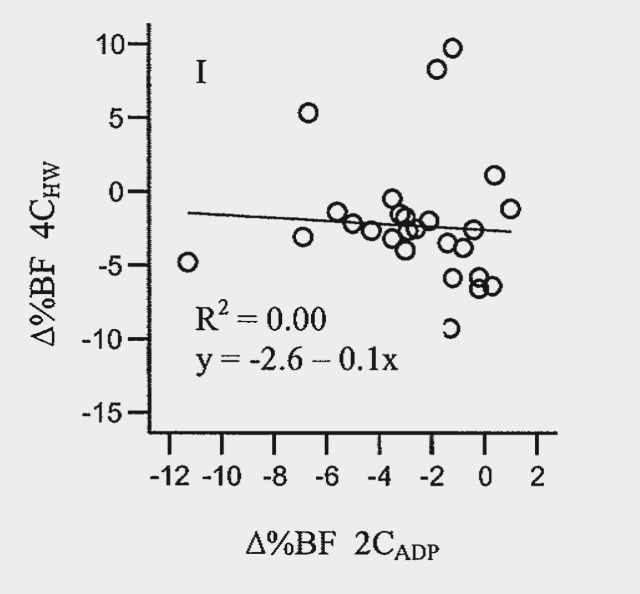Last week I told you how body fat testing is a prediction, not a measurement. I also talked about the 2-compartment model, its limitations, and how hydrostatic weighing is reasonably accurate for groups but can have an error rate of as high as 6% in individuals.
Hydrostatic weighing isn't the only 2-compartment model out there. Here I will discuss another 2-compartment model: the Bod Pod.
Bod Pod = Bad
The Bod Pod is based on similar principles to underwater weighing; thus you would think it would have similar error rates. In some instances, this is true; one study found error rates of about 2% on average, but errors of up to 6% in individuals. However, other research on the Bod Pod has shown error rates higher than underwater weighing; one study found an average difference of 5.3% between the Bod Pod and a 4-compartment model, and an error rate of up to 15% in individuals!
One of the reasons the Bod Pod is worse than underwater weighing is because there are more variables that can affect the results. For example, facial hair, body temperature, moisture, and the tightness of the spandex or swimsuit can all alter the results.
And, like underwater weighing, the Bod Pod can have errors when tracking changes over time. In fact, one study showed the Bod Pod to be very poor at tracking changes over time. Here's a chart from that study:
The X-axis of this chart shows the change in % body fat for the Bod Pod, while the Y-axis shows the change for the 4-compartment model. Each circle is an individual subject. You can see the big disparity between the two method. For example, one person gained 10% body fat but showed a loss of 1% with the Bod Pod. Another person lost nearly 10% bodyfat but showed only a loss of 1% with the Bod Pod. Another person lost about 5% body fat but showed a loss of 11% with the Bod Pod.
Do you see that "R squared = 0" statement in the chart? Do you also see the flat line in the chart? That means there was no relationship between changes observed with the 4-compartment model and changes observed with the Bod Pod. There was practically no agreement between the two methods. This means the Bod Pod is horrible at assessing changes within individuals over time. Now compare this chart to the one from last week on hydrostatic weighing. You can see that hydrostatic weighing did much better; even though there's some large error within certain people with hydrostatic weighing, there is at least reasonable agreement between hydrostatic weighing and a 4-compartment model in most people.
The Bod Pod: The Verdict
The Bod Pod does OK when looking at group averages, with some studies showing error rates of around 2%; however, other studies have indicated average error rates of over 5%. The individual error rate for the Bod Pod can be unacceptably high in some individuals, and the Bod Pod is horrible for tracking change over time. For these reasons I would recommend against using the Bod Pod as a body composition assessment tool. Hydrostatic weighing, despite some of its problems, is much more reliable.
Underwater weighing and the Bod Pod are not as widely available as other techniques, such as bioelectrical impedance (BIA) or skinfolds. Click here to read Part 4 of this series, where I discuss the accuracy, err, I mean inaccuracy, of BIA...



I’ve done the bodpod several times, the inbody 270,570, and I think it’s a 770. I’ve also done the FIT3D scan. Additionally, I do regular caliper assessments. My issue with the above mentioned Air displacement / impedance tests… they vary widely and seem to be extremely sensitive to errors… why would caffeine or having in body lotion create such significant results in the podpod?
Calipers: 19% (yes, subcutaneous fat) – AM
In body avg: 22.5% – afternoon
Fit 3d: 27% – afternoon
BodPod: 26.8% – AM
This is nuts!
I would recommend against using the Bod Pod as a body composition assessment tool. Hydrostatic weighing, despite some of its problems, is much more reliable. Underwater weighing and the Bod Pod are not as widely available as other techniques, such as bioelectrical impedance (BIA) or skinfolds.
Excellent post.
One thing I have noticed about certain sites is that, even though they have tons of content, the site looks great and the headlines are eye catching is that the material is simply filler. It’s downright unreadable. You can forget it 6 seconds after you read it. Not the case with your post though, really enjoyed it reading it and it held my attention all the way through! Keep it up.